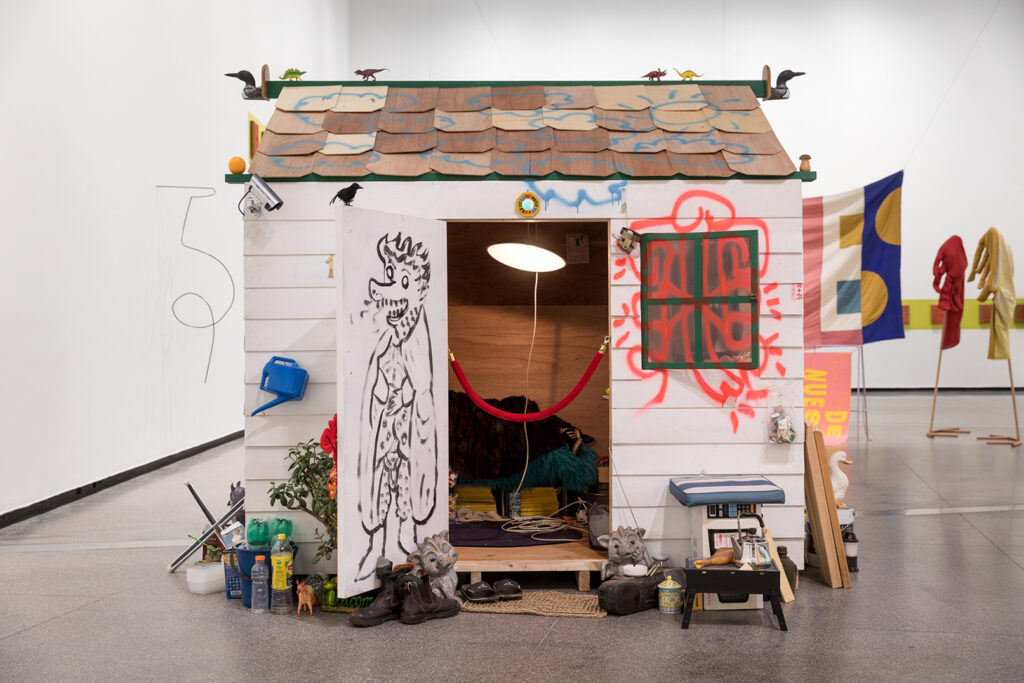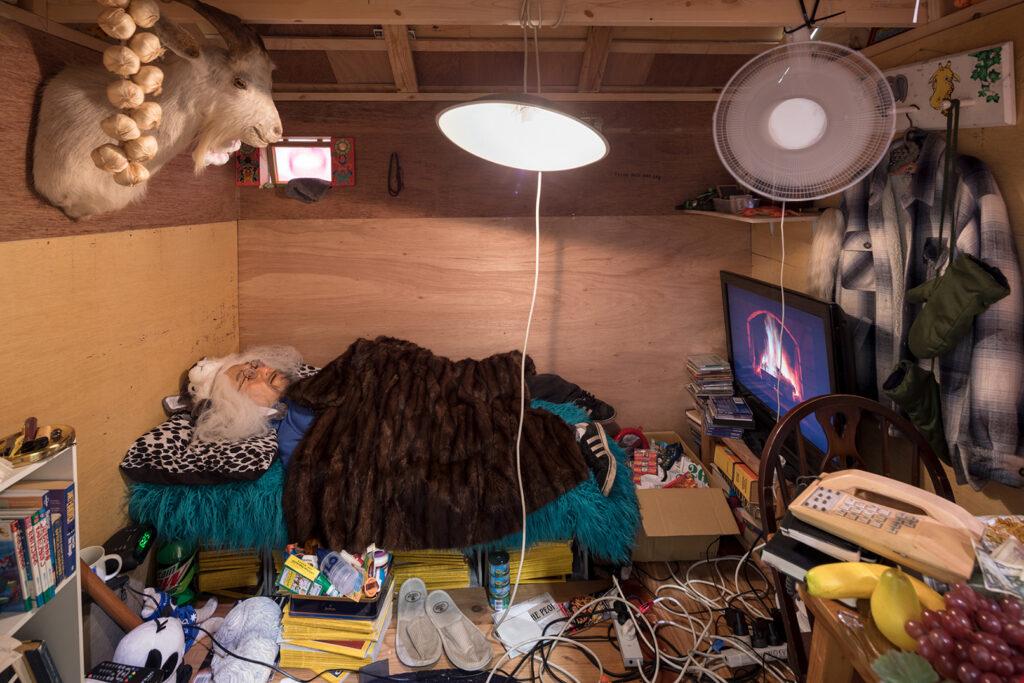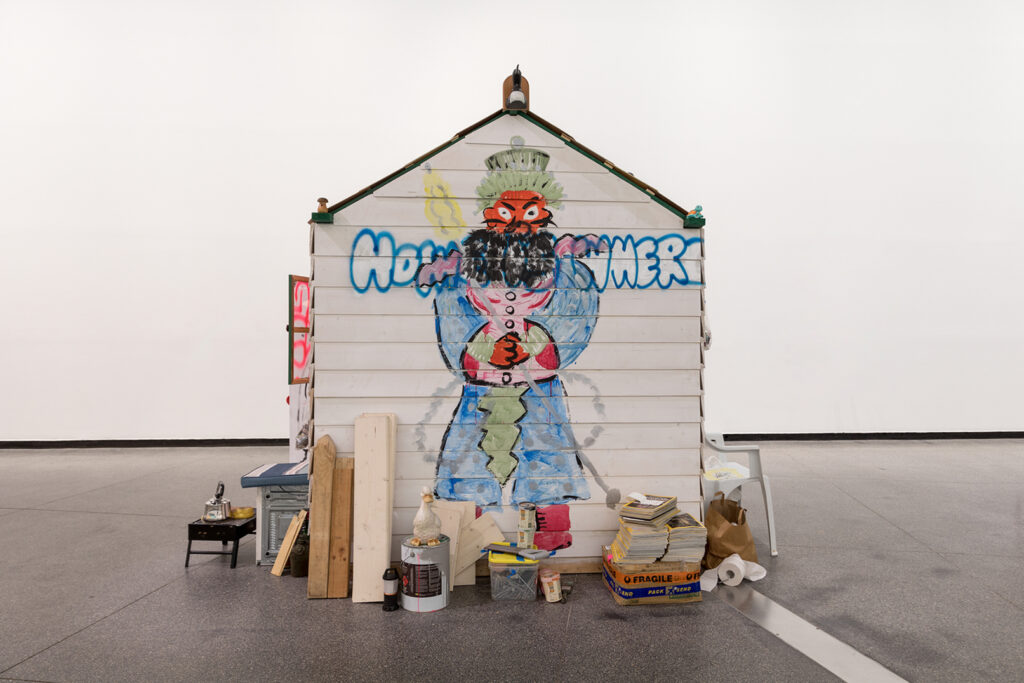
If the world was ending, what would you hoard? Food? Water? Books? Or, à la 2020, toilet paper?
everyone is dead, except for me, again, currently on at HOTA, invites viewers into Jason Phu’s melancholic and whimsical post-apocalyptic world. Part mausoleum, part shrine, Phu invites us to reflect upon the objects and memories we entomb ourselves with in this irreverent musing on hoarding, loneliness, and the end of the world.
The show takes its title from the exhibition’s central work, everyone is dead, except for me. everything is futile, and i am tired. i wait in my little house, for the winter to take me (2022/24), which first appeared at the Australian Centre for Contemporary Arts as part of the 2022 Macfarlane Commissions. This work: a small white house, its doors and walls painted with brightly coloured god-figures drawn from the artist’s Chinese-Vietnamese heritage, and overlaid with graffiti-like scrawls, occupies the centre of the room. The door to the house is open, inviting visitors to step up to its sill and between detritus piled on either side. This includes buckets filled with empty bottles, discarded takeaway boxes repurposed as paint palettes, boots slipped off and cast aside, cigarettes, whisky bottles, a makeshift stove; just some of the ephemera of daily life.

On peering inside, one sees that this debris fills the interior of the house as well. Books and sketch pads spill from every shelf and desk amidst canned food, religious effigies, toys, CDs, video games, crumpled papers, a plastic bow and arrow, and animal figures. An artificial fireplace flickers on a TV screen. And there, in the corner of the room, under the watchful gaze of a taxidermied goat’s head and almost completely consumed by the piles of clutter, lies the sleeping simulacra of the artist as an elderly man. His snores and whistles fill the four walls of this tiny house.
The house was inspired by Phu’s visit, during his 2009 artist residency in Nova Scotia, to a replica of the forest home of Canadian folk artist, Maud Lewis. Lewis covered every surface of her house with brightly coloured paintings that drew on childhood memories. In an interview with journalist Mahmood Fazal, Phu reflected upon Lewis’ house: “It wasn’t that spectacular. It was just a little house she lived in and painted on. It’s always stuck with me.”1 Against the wilderness, and the weight of the world, the house becomes a refuge; the mundane, a comfort; the everyday, magical.
One of the most charming aspects of Phu’s exhibit is its lack of didactics, exhibition texts, or artwork titles, which enabled me to become fully immersed in the artist’s creation. I entered an explorer, inquisitive as I pieced together the traces of a fantasy world that may have been; suspending reality at the gallery threshold. A lilting soundscape fills the room, interweaving flute and loon song. The bucolic birdcall is perhaps evocative of the Nova Scotia forest where Phu encountered Lewis’ own tiny outpost, and enhances the works’ feeling of otherworldly isolation. The gallery walls are covered in bright murals: dragons and beasts in sprawling, calligraphic brush strokes, large red and blue figures engaged in fisticuffs. On one wall, small figures face each other in battle. On one side of the fight are figures on horseback and on the other are centaur-like creatures. In Phu’s naïve style, these read as pictographs, telling a story of what may have transpired. Behind the house, the painted imagery of trees, sun, and moon complete the forest scene and suggest the passing of days. Finally, the rear of the house is stacked high with National Geographic magazines, artefacts of Phu’s real-life hoarding. Their covers feature robots, Pharaohs, and nuclear bombs; conflating past civilisations, the future, and the end-of-days within the domestic aesthetic of the yellow-bordered tomes.

As you approach the house, strange beasts guard its entrance, speaking perhaps to the persistence of danger in this strange world. To the left, a pig-faced man sits atop a furred white creature, brandishing a firearm. And to the right, the elderly Phu is joined by a tiger and a panda as they ride another broad-faced red monster with a flowing green mane. Behind them, another being lies prone, still clutching a glinting scimitar, its cheetah-head separated from its body. This fallen figure affirms that despite the child-like whimsy and humour in Phu’s post-apocalyptic imagination, threats are imminent.
Phu’s work occupies a loose temporality, shifting between past and future. Although the artist depicts himself as an elderly man, asleep in the house, his childlike wall murals and toy-like monsters also place the work within the imagination of and nostalgia for youth, prompting the question: Is the elderly Phu dreaming of days long passed or is the work the playful imaginings of a child brought to life? everyone is dead, except for me, again also echoes with Phu’s childhood anxieties of being left alone. He says that, “I used to draw little houses with my family and dog. Everything had to be there. A submarine and a plane. Enough food. So that we could always survive.”2 This idea of survival carries into the work’s present-day preoccupation with hoarding and doomsday prepping.
Although the work is not an intentional response to the liminal, lock-down era of the 2020s, it resonates with the pandemic’s attendant anxieties about catastrophe and isolation. The work’s essence can be distilled as the importance of Phu’s connection to his friends and family over the valuing of material things. The artist’s avatar, solitary and aged in his little house in the woods, speaks to a life lived in the wrong direction, when hoarding was chosen over community. Whereas material objects come and go, Phu reflects upon the importance of his relationships to friends and family: “If I lost them, I’d lose a bit of myself… Without them, I’m just a ghost.”3 Alone, the house becomes a tomb: a living mausoleum.
As the self-professed last person alive, this tomb is also a shrine to what remains at the end of days. Religious effigies and Daoist memorabilia are conflated with books and video games, offerings of tinned tuna and peaches. In this convergence of ancient and pop-cultures, Phu further ponders what we may worship in a future where the only stories that survive are those that have been hoarded. (In a tongue-in-cheek answer, a tiny pencil scribbling near the roof of the house states: “I am god.”)Through whimsy and humour, Phu weaves a contemporary fable: a cautionary tale of loneliness and survival. I left the strange world of everyone is dead, except for me, again enchanted, pondering what I might bring with me to my own outpost at the end of the world—and more importantly, who.
- Mahmood Fazal, “Home is where the anxiety is,” in Like a Wheel that Turns: The 2022 Macfarlane Commissions, ed. Max Delany & Annika Kristensen (Australian Centre for Contemporary Art, 2022), 81-83. ↩︎
- Fazal. ↩︎
- Fazal. ↩︎
Felicity Andrews is an emerging arts worker who writes, researches, and creates on Yugerra/Turrbal Land, Meanjin. She holds a Masters of Museum Studies and is currently undertaking a PhD in Art History at the University of Queensland. She works as a cultural mediator at the University of Queensland Art Museum.



